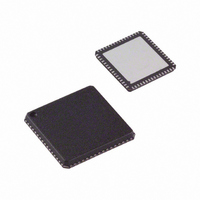ADV7181BCP Analog Devices Inc, ADV7181BCP Datasheet - Page 27

ADV7181BCP
Manufacturer Part Number
ADV7181BCP
Description
IC VIDEO DECODER NTSC 64-LFCSP
Manufacturer
Analog Devices Inc
Type
Video Decoderr
Specifications of ADV7181BCP
Applications
Recorders, Set-Top Boxes
Voltage - Supply, Analog
3.15 V ~ 3.45 V
Voltage - Supply, Digital
1.65 V ~ 2 V
Mounting Type
Surface Mount
Package / Case
64-LFCSP
Adc/dac Resolution
9b
Screening Level
Industrial
Package Type
LFCSP EP
Pin Count
64
Lead Free Status / RoHS Status
Contains lead / RoHS non-compliant
For Use With
EVAL-ADV7181BEB - BOARD EVALUATION FOR ADV7181
Lead Free Status / RoHS Status
Compliant, Contains lead / RoHS non-compliant
DCT[1:0] Digital Clamp Timing, Address 0x15 [6:5]
The Clamp Timing register determines the time constant of the
digital fine clamp circuitry. It is important to realize that the
digital fine clamp reacts very fast since it is supposed to
immediately correct any residual dc level error for the active
line. The time constant of the digital fine clamp must be much
quicker than the one from the analog blocks.
By default, the time constant of the digital fine clamp is adjusted
dynamically to suit the currently connected input signal.
Table 56. DCT Function
DCT[1:0]
00
01
10 (default)
11
DCFE Digital Clamp Freeze Enable, Address 0x15 [4]
This register bit allows the user to freeze the digital clamp loop
at any time. It is intended for users who would like to do their
own clamping. Users should disable the current sources for
analog clamping via the appropriate register bits, wait until the
digital clamp loop settles, and then freeze it via the DCFE bit.
Table 57. DCFE Function
DCFE
0 (default)
1
LUMA FILTER
Data from the digital fine clamp block is processed by three sets
of filters. The data format at this point is CVBS for CVBS input
or luma only for Y/C and YPrPb input formats.
•
•
Luma antialias filter (YAA). The ADV7181 receives video
at a rate of 27 MHz. (In the case of 4× oversampled video,
the ADCs sample at 54 MHz, and the first decimation is
performed inside the DPP filters. Therefore, the data rate
into the ADV7181 is always 27 MHz.) The ITU-R BT.601
recommends a sampling frequency of 13.5 MHz. The luma
antialias filter decimates the oversampled video using a
high quality, linear phase, low-pass filter that preserves the
luma signal while at the same time attenuating out-of-band
components. The luma antialias filter (YAA) has a fixed
response.
Luma shaping filters (YSH). The shaping filter block is a
programmable low-pass filter with a wide variety of
responses. It can be used to selectively reduce the luma
Description
Slow (TC = 1 sec).
Medium (TC = 0.5 sec).
Fast (TC = 0.1 sec).
Determined by ADV7181 depending on video
parameters.
Description
Digital clamp operational.
Digital clamp loop frozen.
Rev. B | Page 27 of 104
•
Figure 11 through Figure 14 show the overall response of all
filters together. Unless otherwise noted, the filters are set into a
typical wideband mode.
Y Shaping Filter
For input signals in CVBS format, the luma shaping filters play
an essential role in removing the chroma component from a
composite signal. YC separation must aim for best possible
crosstalk reduction while still retaining as much bandwidth
(especially on the luma component) as possible. High quality
YC separation can be achieved by using the internal comb filters
of the ADV7181. Comb filtering, however, relies on the
frequency relationship of the luma component (multiples of the
video line rate) and the color subcarrier (Fsc). For good quality
CVBS signals, this relationship is known; the comb filter
algorithms can be used to separate out luma and chroma with
high accuracy.
In the case of nonstandard video signals, the frequency
relationship may be disturbed and the comb filters may not be
able to remove all crosstalk artifacts in an optimum fashion
without the assistance of the shaping filter block.
An automatic mode is provided. Here, the ADV7181 evaluates
the quality of the incoming video signal and selects the filter
responses in accordance with the signal quality and video
standard. YFSM, WYSFMOVR, and WYSFM allow the user to
manually override the automatic decisions in part or in full.
video signal bandwidth (needed prior to scaling, for
example). For some video sources that contain high
frequency noise, reducing the bandwidth of the luma
signal improves visual picture quality. A follow-on video
compression stage may work more efficiently if the video is
low-pass filtered.
Digital resampling filter. This block is used to allow dynamic
resampling of the video signal to alter parameters such as
the time base of a line of video. Fundamentally, the resam-
pler is a set of low-pass filters. The actual response is chosen
by the system with no requirement for user intervention.
The ADV7181 allows selection of two responses for the
shaping filter: one that is used for good quality CVBS,
component, and S-VHS type sources, and a second for
nonstandard CVBS signals.
The YSH filter responses also include a set of notches for
PAL and NTSC. However, it is recommended to use the
comb filters for YC separation.
ADV7181












